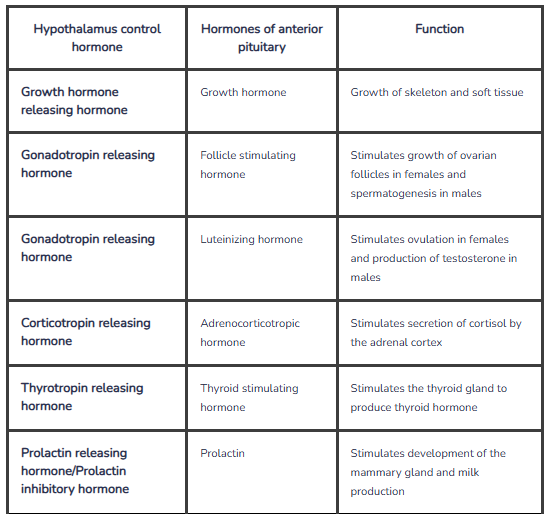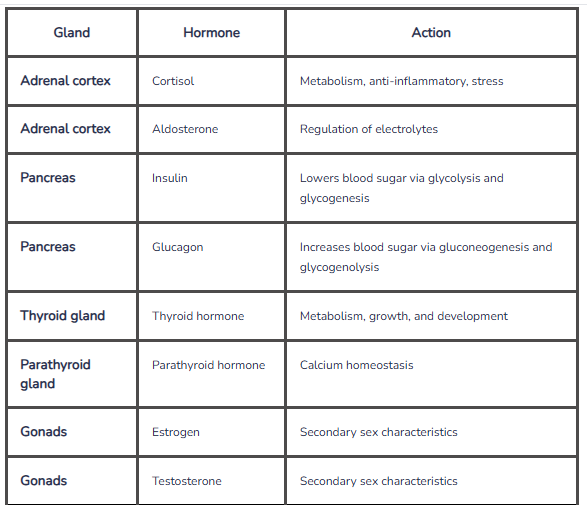Endocrine System
1/7
There's no tags or description
Looks like no tags are added yet.
Name | Mastery | Learn | Test | Matching | Spaced |
|---|
No study sessions yet.
8 Terms
Steroid Hormones
Lipophilic (fat-soluble):
Can easily pass through the lipid bilayer of cell membranes
Act on intracellular receptors:
Once inside the cell, they bind to receptors in the cytoplasm or nucleus
The hormone-receptor complex then acts as a transcription factor, regulating gene expression
Hormones are chemical messengers secreted into the bloodstream. Blood carries hormones to their target tissue where they bind to specific receptors to produce a specific response. Hormones can be:
Steroid hormones: These are hydrophobic so they are carried by protein transporters in the blood. When they get to their target tissue, they cross the cell membrane and act on receptors inside the cell. Steroid hormones are produced mainly by the gonads (estrogen, progesterone, and testosterone) and the adrenal glands (cortisol and aldosterone).
Nonsteroid Hormones
Non-steroid hormones: Non-steroid hormones (examples are polypeptide hormones and glycopeptides) are hydrophilic. They are carried by blood to their target tissue. As they are lipophobic and are not fat soluble, they do not cross the plasma membrane but bind to receptors on the cell surface. Examples are insulin, thyroid hormone, glucagon, etc. Most hormones are non-steroid hormones.
Hydrophilic Nature: Non-steroid hormones, such as peptide and glycoprotein hormones, are typically hydrophilic (water-soluble). This means they cannot easily cross the lipid bilayer of cell membranes. In contrast, steroid hormones are hydrophobic (lipophilic) and can readily pass through cell membranes due to their fat-soluble nature.
Hormones and what they stimulate
Thyroid stimulating hormone stimulates the thyroid gland to produce and secrete thyroid hormone.
Oxytocin stimulates uterine contraction and milk ejection. Prolactin stimulates milk production.
FSH stimulates spermatogenesis and maturation of ovarian follicles. Luteinizing hormone stimulates production of testosterone.
Growth hormone (somatotropin) stimulates growth of bone, skeletal muscle, and soft tissue. Estrogen, progesterone, and testosterone are responsible for secondary sex characteristics.
Hypothalamus control Hormones
Luteinizing hormone and follicle stimulating hormone act on the gonads.
Luteinizing hormone (LH) is produced by the anterior pituitary and targets the gonads:
In females: LH stimulates ovulation and the production of progesterone in the ovaries.
In males: LH stimulates Leydig cells in the testes to produce testosterone.
Thyroid-stimulating hormone acts on the thyroid gland to cause production and secretion of thyroid hormone.
Growth hormone acts on body tissues to stimulate growth.
Prolactin acts on the breast tissue to stimulate growth and milk production.
Oxytocin which is a posterior pituitary gland secretion acts on the uterus to stimulate contraction and also acts on mammary to stimulate milk ejection.

Endocrine Hormone
HYPOTHALAMUS controls the activity of the endocrine system
Endocrine hormones are chemical messengers that act on distant tissues. When chemicals act on nearby cells, it is called paracrine signaling, and an autocrine action is when hormones act on the same glands that secrete them.
Hormones are chemical messengers and not electrical messengers. Excitable tissues, like nervous tissue, utilize electrical impulses.
Hormones are chemical messengers that carry information to cells to help maintain homeostasis. They carry out several functions, including:
Metabolism
Growth and development
Reproduction
Development of sexual characteristics
Energy storage
Fluid regulation
Glands and hormones
Pituitary gland is “master gland”
It produces several hormones called tropic hormones that regulate the activities of several endocrine glands.
The anterior pituitary gland produces growth hormone (somatotropin), adrenocorticotropic hormone, thyroid stimulating hormone, luteinizing hormone, follicle stimulating hormone, and prolactin.
The posterior pituitary gland originates from nervous tissue. Their cell bodies are in the hypothalamus and their axon is in the hypothalamo-hypophyseal tract. Hormones are produced in the cell bodies in the hypothalamus and stored in vesicles in the posterior pituitary. Posterior pituitary hormones are:
Antidiuretic hormone which is triggered by increased osmolarity. Antidiuretic hormone acts on the kidneys to increase water reabsorption.
Oxytocin stimulates uterine contraction and lets down of milk.

Produced by adrenal glands
The adrenal gland lies on top of the kidneys. It is composed of the:
Adrenal cortex, which produces cortisol, aldosterone, and androgens like dehydroepiandrosterone.
Adrenal medulla, which is stimulated by the sympathetic nervous system to produce epinephrine and nor-epinephrine responsible for fight and flight response.
The male gonads are the main glands that produce androgens but the adrenal glands also produce small amounts of androgens.
Cortisol stimulates the metabolism of carbohydrate, fat, and protein. It also has anti-inflammatory activity. It helps the body cope with stress.
Aldosterone regulates electrolytes, especially sodium and potassium.
The thyroid hormone acts on several tissues to increase metabolism, oxygen consumption, glucose uptake, and growth and development.
Hypothalamus
The hypothalamus is controlled by a feedback mechanism. This helps to prevent disease states by abnormal production of hormones. Most hormones act by negative feedback except for oxytocin which acts by positive feedback.
In late pregnancy, stretching of the uterine walls stimulates release of oxytocin.
Oxytocin stimulates contraction of the uterus and, as the baby moves down, the cervix stretches.
This sends a positive feedback to the hypothalamus to produce more oxytocin.
More oxytocin leads to increased contraction and the amplification continues throughout labour until delivery.
The hypothalamus is principally controlled by a negative feedback mechanism. In negative feedback, a hormone feeds back to inhibit its own production. Once an adequate amount of the hormone has been produced, it sends back signals to inhibit its production. This is useful since it prevents excess amounts of the hormone from being produced.
For example, the hypothalamus releases corticotropin hormone which acts on the anterior pituitary to cause production of adrenocorticotropic hormone (ACTH). ACTH acts on the adrenal cortex to cause secretion of cortisol. When an adequate quantity of cortisol is produced, it feeds back to shut down further production of CRH by the hypothalamus. This ultimately slows down production of cortisol.